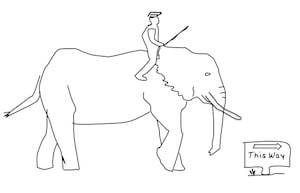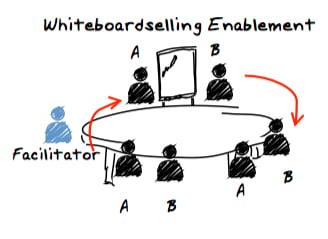I'm in one of America's premier convention cities as I write this, having attended a sales Kick-off and sales enablement event for a major technology company. This event, like many prior events I have attend was a lot of fun and a great time was had by all.
2 min read
Its Sales Kickoff Season – A time of Rah Rah, Renewal and Hangovers
By Mark Gibson on Fri, Nov 30, 2012
Topics: sales kick-off whiteboard enablement
3 min read
Visual Storytelling, PowerPoint and Memory
By Mark Gibson on Tue, Feb 07, 2012
Visual Storytelling is the future of presenting
Users of PowerPoint like it because it's easy to create and modify presentations and that's the good news. The bad news is when you are on the other side of the presentation - in the audience as a salesperson at a kick-off, or as a prospective customer in a sales or marketing presentation or in a business setting.
Topics: whiteboard enablement whiteboardselling visual storytelling
4 min read
Lessons Learned from a Month on the Road with WhiteboardSelling
By Mark Gibson on Tue, Dec 27, 2011
I ran WhiteboardSelling Enablement events in Melbourne and Sydney in Australia, Cologne in Germany and here in Silicon Valley CA. The smallest group was about 25 and the largest was about 90 people.
In every case, the WhiteboardSelling Enablement method was very well received and sales and support people had learned and could tell their story after this half day session.
To illustrate how well this enablement method works, a new hire Pitney Bowes product manager who participated the WhiteboardSelling Symposium in Melbourne, gave a great Whiteboard demonstration to lead off the first session the very next day in Sydney. Our executive sponsors were well pleased with the training outcomes in every case.
Whiteboard Selling Insights
1. No Whiteboard survives contact with the field
No matter how smart the development team is that created the whiteboard story, there is always a new perspective, relevant insight or an anecdote from the sales team that we learn at the Symposium that will enrich the whiteboard story.For this reason we like to hold a feedback session immediately following the enablement symposium to capture suggestions to improve the whiteboard. We have added an additional echo-back into our Admarco best-practices whiteboard development process to incorporate changes.
2. No Whiteboard Survives contact with the customer
In the same way that no battle plan survives contact with the enemy, no Whiteboard story survives contact with the customer and salespeople need to know the whiteboard so they can give it in any order and develop the customer conversation.A comment we ofter hear during the symposium is that the Whiteboard script is too prescriptive. We want participants to learn how to draw the whiteboard and tell their story and recommend the following;-
- to follow the script initially,
- to get to know the script (we take a lot of time to figure out the best way to capture value creation),
- then to forget the script once they have internalized it and become competent in telling the story.
In real life the customer is going to say and do things that are unexpected and for this reason we suggest that salespeople practice the whiteboard and that their sales managers have them present on a weekly basis for the month following the Symposium to master the whiteboard.
3. You don't have to start at the start and you don't have to finish the Whiteboard
PowerPoint is a linear method of presenting that was designed to make it easy for the presenter to create and give presentations. Most PowerPoint sales presentations are by their nature fixed in structure and focused on the supplier and their products. The WhiteboardSelling Enablement method is a rapid way to capture and enable salespeople to know and tell their story.In every Symposium we see individuals exercising creativity in telling their story...there is only one story, but you can tell it a thousand different ways.
- We coach salespeople to follow the buyer in conversation and let the whiteboard story unfold naturally from that dialog.
- Don't sweat if you don't finish, you may only cover half of your story in the time allotted and still achieve your meeting goal.
- Once you know the Whiteboard, you may not even have to do a whiteboard at all....just engage the buyer in conversation and stay in the moment.
4. Group participants by local language in the Symposium
When faced with an International multi-lingual audience in the training environment, we recommend grouping tables of 6 by native language.The WhiteboardSelling Enablement Symposium may push individuals beyond their comfort-zone into the panic zone in the first round of presentations and having them present in their native language will reduce the stress of having to translate the whiteboard while trying to learn it.
5. Get the red stuff out and on the board
I have found whiteboarding to be a very natural way of engaging buyers. Compared to PowerPoint there is a much more natural flow in the conversation. The use of color plays an important part of the whiteboard development and WhiteboardSelling uses the following convention;Black = Current state - the "as is"
Red = Challenges and problems with the current situation
Green = Future state - "as it could be"
Blue = Proof points, next steps.
Salespeople should encourage buyers to talk about their challenges once rapport and trust are established and capture those challenges in red on the whiteboard.
Getting the problems out and in red on the whiteboard enables the conversation to focus on the issues that are important to the buyer and to have your capabilities unfold naturally in conversation.
6. What if it's not Going Well
We have all been in situations where for some reason the meeting is not going well and the buyer is not engaging in the conversation. I often get asked what to do in this situation. My advice is to bail-out.You could ask the buyer, "I get the feeling that now is not a good time for this conversation.....would you prefer that we reconvened at another time or with another group?". It may save you and the buyer time and if the buyer really is interested, they may re-engage.
Topics: whiteboard enablement whiteboardselling
3 min read
Product Training Doesn't Work- Get Sales to DO Product Training
By Mark Gibson on Wed, May 18, 2011
Getting Sell-through
I asked 10 people in B2B product marketing or product management the same question "How long after new product training does it take for you to get meaningful sell through of the new product?"Sell-through varied from 6-12 months and in one case, 18 months, with a lot of head shaking, groans and frowned expressions from responders.
In a more detailed conversation, I spoke this week with a prospective client running sales operations in the medical software field, regarding their planned sales training and certification program.
I asked if they had introduced any new products in the past year and if they had issues in getting sell-through.
This is his response, " We introduced the product with a strong message and clear value-prop into a market we are represented in strongly. Unfortunately we have only achieved 40% of the $3.4M we expected to sell in the first 6 months after introduction".
I asked if he could describe their product introduction process....does any of the following sound familiar?
THE OLD WAY OF PRODUCT TRAINING
1. "Our Product Management team had worked for months to create and package the new product, ready for training at the Kick-off in November.2. At the event, the product was presented in a PowerPoint presentation, followed by a demonstration. This was followed by presentation on use cases and ROI impact analysis. It was a strong launch.
3. Subsequent regional training and group Webinars were held to ensure the sales team understood the product.
4. Product management created supporting PowerPoint presentations, .pdf's and created a resource center in Salesforce.com to support sales efforts.
5. The Website product messaging was consistent with the sales collateral."
I then asked what went wrong and why he felt they had they fallen so far short after such a strong launch.
"Some of the sales guys have gotten it and are doing well with the new product. The majority are not hitting their numbers, and these reps have a tendency to rely on PowerPoint to do the selling and their conversations are all around product instead of getting the business conversation on the table."
If the old (current) way of product training doesn't work, what does?
Having been through many of the traditional product training events described above in my career, and for the past six months, experiencing the new way of product training with some of the smartest sales enablement teams in the industry, I have some good news.
Instead of frustration in product management andsales enablement at salespeople doing their own thing and disappointing new product sell-through, there is a much better way of introducing new products.
GET THE SALES TEAM TO DO THE PRODUCT TRAINING
In our typical Visual Storytelling training session, each person will either see the Visual Confection, or whiteboard presented up to 10 times and give the presentation a minimum of six times each in the training session.They will be able to meet new clients the next day, engage buyers around their issues and use the visual confection in a conversational style.
If you want the sales team to learn a new product and get them to sell it quickly, then get them to DO the product training.
Topics: sales performance whiteboard enablement product training
3 min read
Training 3200 to Sell Differently in Four Hours using a Whiteboard
By Mark Gibson on Wed, Mar 09, 2011
I was in Las Vegas last month with a team of eight sales enablement professionals from WhiteboardSelling to facilitate a Whiteboard Selling Symposium as part of a global sales kick-off event for over three thousand front line sales and presales support people. Our client, a major player in the virtualization business (I'm writing this as an affiliate partner of WhiteboardSelling) will remain nameless as we are under NDA.







